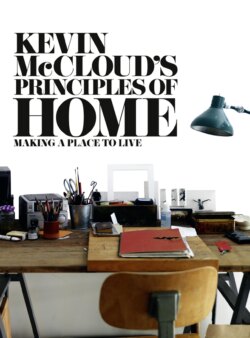Читать книгу Kevin McCloud’s Principles of Home: Making a Place to Live - Kevin McCloud - Страница 7
ОглавлениеTEST ONE: WHICH IS THE MOST ENVIRONMENTALLY FRIENDLY HOUSE?
A. A 500-year-old farmhouse, built from local materials – any stones that were just turned up out of the field – and oak trees from the farm in which it sits, with stone floors laid on the earth and thick walls with a high thermal mass. Albeit the place is listed and hasn’t got double glazing.
B. A house built by Ben Law in the forest in Sussex, entirely from the forest in Sussex. Ben cut 10,000 shingles from his own coppiced chestnut trees. The frame is coppiced chestnut and the oak cladding, straw-bale insulation and ash window frames are all from his woods and cut and assembled by him. This place does have double glazing, and it’s off grid, has its own water supply and is heated by Ben’s own wood thinnings from his sustainable forestry business, making charcoal and hurdles.
C. A three-bedroom family home in Scotland. It has super-insulated walls, it’s airtight, it has a state-of-the-art Panelvent timber panel construction sitting on a concrete plinth for high thermal mass, it’s triple-glazed and it comes with a heat recovery system.
So which is greenier than green? Well, it has to be Ben’s, of course. Maybe followed by the Scottish timber box. With the farmhouse a poor third, maybe. Which, it turns out, has no oil-fired range, has 10 inches of loft insulation and is heated with a biomass boiler.
Answer
TEST TWO: WHICH IS THE MOST ECO-FRIENDLY CAR IN THE LIST BELOW?
A. A Toyota Prius
B. A 1937 Alfa Romeo tourer
C. A Ferrari
D. A 37-year-old Bond 875 (my first car)
E. The Innocent Smoothie van
F. An Aston Martin DB9
G. A Range Rover
You might plump for the Prius as the angel of the pack and the Range Rover as the devil. Let me ask you another question: if you had the money, would you commission a small firm of English cabinet-makers to make you a bespoke, crafted piece of furniture? Or buy a cheap copy from the Far East? Well, the more ethical solution has to be the former: it’s a local transaction, it involves much less shipping, it creates relationships between the makers and the owner. The automotive equivalent is buying an Aston Martin over a Toyota Prius.
Surely this is rubbish. The Prius emits 145 grams of carbon per kilometre while the Aston emits nearly 500. But even these figures are meaningless. Who is the biggest environmental sinner? The man who drives his Prius 20 miles to and from work each day? Or the man who travels 50 miles on the train? Or the man who owns an Aston Martin and walks across his yard to his office and drives his car at weekends only? It’s probably the Prius driver.
Answer
